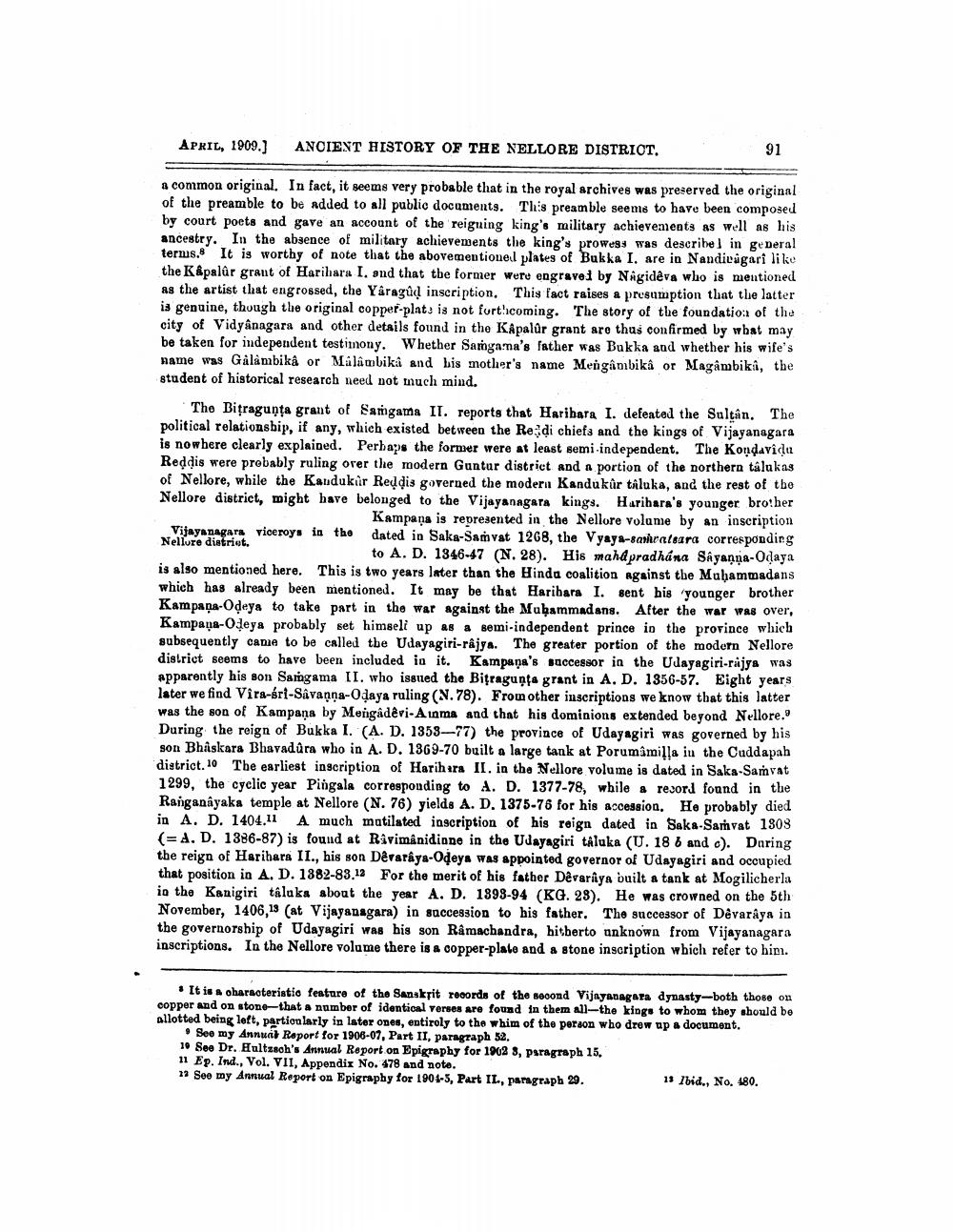________________
APRIL, 1909.]
ANCIENT HISTORY OF THE NELLORE DISTRICT.
a common original. In fact, it seems very probable that in the royal archives was preserved the original of the preamble to be added to all public documents. This preamble seems to have been composed by court poets and gave an account of the reigning king's military achievements as well as his ancestry. In the absence of military achievements the king's prowess was describel in general terms. It is worthy of note that the abovementioned plates of Bukka I. are in Nandivagari like the Kapalûr grant of Harihara I. and that the former were engraved by Nagidêva who is mentioned as the artist that engrossed, the Yâragûd inscription. This fact raises a presumption that the latter is genuine, though the original copper-plate is not forthcoming. The story of the foundation of the city of Vidyanagara and other details found in the Kapalûr grant are thus confirmed by what may be taken for independent testimony. Whether Samgama's father was Bukka and whether his wife's name was Galambikâ or Mâlâmbika and his mother's name Mengâmbikâ or Magâmbika, the student of historical research need not much mind.
The Bitragunța grant of Samgama II. reports that Harihara I. defeated the Sultan. The political relationship, if any, which existed between the Re di chiefs and the kings of Vijayanagara is nowhere clearly explained. Perhaps the former were at least semi-independent. The Kondavidu Reddis were probably ruling over the modern Guntur district and a portion of the northern tâlukas of Nellore, while the Kandukur Reddis governed the modern Kandukûr taluka, and the rest of the Nellore district, might have belonged to the Vijayanagara kings. Harihara's younger brother Kampana is represented in the Nellore volume by an inscription Vijayanagara viceroys in the dated in Saka-Samvat 1268, the Vyaya-samvatsara corresponding Nellore district. to A. D. 1346-47 (N. 28). His mahapradhána Sayanna-Odaya is also mentioned here. This is two years later than the Hindu coalition against the Muhammadans which has already been mentioned. It may be that Harihara I. sent his younger brother Kampana-Odeya to take part in the war against the Muhammadans. After the war was over, Kampana-Odeya probably set himself up as a semi-independent prince in the province which subsequently came to be called the Udayagiri-râjya. The greater portion of the modern Nellore district seems to have been included in it. Kampana's successor in the Udayagiri-rajya was apparently his son Samgama II. who issued the Bitragunta grant in A. D. 1356-57. Eight years later we find Vira-éri-Savanna-Odaya ruling (N. 78). From other inscriptions we know that this latter was the son of Kampana by Mengâdêvi-Ainma and that his dominions extended beyond Nellore." During the reign of Bukka I. (A. D. 1353-77) the province of Udayagiri was governed by his son Bhaskara Bhavadûra who in A. D. 1369-70 built a large tank at Porumamilla in the Cuddapah district. 10 The earliest inscription of Harihara II. in the Nellore volume is dated in Saka-Samvat 1299, the cyclic year Pingala corresponding to A. D. 1377-78, while a record found in the Ranganayaka temple at Nellore (N. 76) yields A. D. 1375-76 for his accession. He probably died in A. D. 1404.11 A much mutilated inscription of his reign dated in Saka-Samvat 1808 (=A. D. 1386-87) is found at Rivimânidinne in the Udayagiri taluka (U. 18 6 and c). During the reign of Harihara II., his son Dêvaraya-Odeya was appointed governor of Udayagiri and occupied that position in A. D. 1882-83.12 For the merit of his father Dêvariya built a tank at Mogilicherla in the Kanigiri taluka about the year A. D. 1893-94 (KG. 28). He was crowned on the 5th November, 1406,13 (at Vijayanagara) in succession to his father. The successor of Dêvarâya in the governorship of Udayagiri was his son Râmachandra, hitherto unknown from Vijayanagara inscriptions. In the Nellore volume there is a copper-plate and a stone inscription which refer to him.
91
It is a characteristic feature of the Sanskrit records of the second Vijayanagara dynasty-both those on copper and on stone-that a number of identical verses are found in them all-the kings to whom they should be allotted being left, particularly in later ones, entiroly to the whim of the person who drew up a document.
See my Annual Report for 1906-07, Part II, paragraph 52.
10 See Dr. Hultzsch's Annual Report on Epigraphy for 1902 3, paragraph 15.
11 Ep. Ind., Vol. VII, Appendix No. 478 and note.
12 See my Annual Report on Epigraphy for 1904-5, Part II., paragraph 29.
13 Ibid., No. 480.




